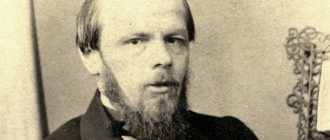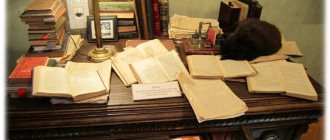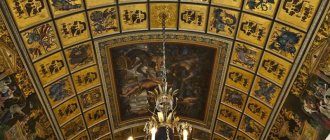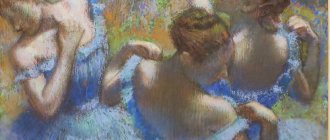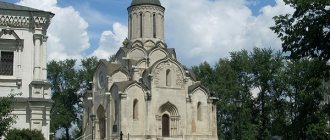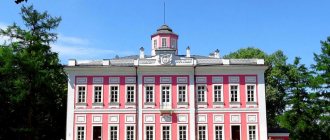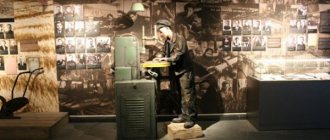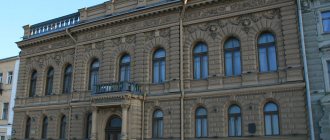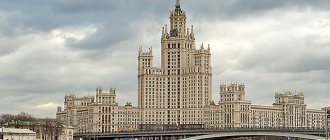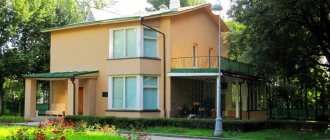The museum-apartment of A. M. Gorky is located in the former Ryabushinsky mansion, built for the family of a young Russian entrepreneur by the famous Moscow architect F. Shekhtel. The luxurious house on Malaya Nikitskaya, in which the writer lived in the last years of his life, is a true masterpiece of architecture of the early twentieth century. It is made in the Russian Art Nouveau style, unusual for Moscow of those years, and its history is connected with three outstanding people who lived at the same time, but had very different destinies. And only one of them is mentioned on the memorial plaque installed on the facade.
Memorial plaque, © Andrey and Valeria
The mansion is one of the few similar objects open to the public located in the center of the capital. Some buildings house government agencies and embassies, where ordinary citizens are not allowed to enter. Its interior decoration has been preserved almost in its original form, conceived and implemented by F. Shekhtel.
Hotels in Moscow near the Gorky Museum-Apartment
Ryabushinsky's mansion
An unusual house with multi-level and multi-format windows, a mosaic frieze with floral motifs and glazed brick trim is considered an adornment not only of Malaya Nikitskaya Street, but of the entire capital. The splendor of the interior decoration is hidden from the eyes of passers-by, but you can see it with your own eyes by visiting the museum-apartment of A. M. Gorky.
Main entrance, © Anna Abrosimova
The mansion was designed by F. Shekhtel under the influence of European Art Nouveau combined with fashion trends of Art Nouveau - a style characterized by the preferential use of natural smooth curves in the architectural appearance and interiors, rather than straight lines and clear angles. A feature of this area also includes the use of new, non-standard technologies. Despite the borrowing of stylistic solutions, F. Shekhtel managed to harmoniously fill them with his own decorative elements and details.
The mansion bears the name of the customer and the first owner of the house - Stepan Ryabushinsky. He was a famous entrepreneur and collector, but most importantly, he belonged to the wealthy Ryabushinsky dynasty and became its worthy follower. Stepan Pavlovich had one of the best collections of icons in Russia and organized grand exhibitions of icon painting, including for the 300th anniversary of the House of Romanov. Thanks to his participation, scientific research was carried out, which made it possible to discover and restore real iconographic masterpieces.
After the October Revolution, Ryabushinsky was forced to leave the country. His collection of icons was confiscated. Some of them were sold, the rest were donated to museums. Fortunately, most of the collection has been preserved and is located in the Tretyakov Gallery. Today there is talk about organizing a permanent exhibition of icons collected by Stepan Pavlovich in one of the Ryabushinsky houses.
Chapel, © Larisa Kiseleva
During Soviet times, the mansion was replaced by several owners from among government agencies. During this time, unique pieces of furniture, lamps and the original fireplace portal, made of marble specially brought from Carrara, disappeared. In addition, the house's unique ventilation system was damaged. The salvation from the final ruin of the mansion was the settlement of the family of a proletarian writer in it in 1931.
Gorky Apartment Museum - official website
Side facade, © Andrey and Valeria
At the intersection of the quietest Malaya Nikitskaya and Spiridonovka, in a luxurious Art Nouveau house built by F.O. Shekhtel, there is the A. M. Gorky House Museum . And before the revolution, the owner of the house was Stepan Ryabushinsky. That’s why some call the mansion Ryabushinsky’s house, and others call it the Gorky Museum. Museum employees talk about the life of the writer, his family, and his work. And if you don’t like long excursions, you can simply relax on a bench in a cozy, shady courtyard, and then see the unearthly beauty of the House’s interiors for yourself.
The building's facades are faced with glazed brick, topped with a ribbon of mosaic frieze depicting irises (pictured above), and the smooth walls are cut through with squares of large windows. This is what the former main door looks like. Today, the entrance to the museum is through the “back door”.
In the summer of 1900, construction began on a luxurious mansion on Malaya Nikitskaya for Stepan Pavlovich Ryabushinsky, one of the representatives of the third generation of the dynasty. Stepan Pavlovich Ryabushinsky is a Russian entrepreneur, banker, collector, philanthropist, together with his brother Sergei he founded the first automobile plant in Russia, AMO, now the Likhachev Plant. Malaya Nikitskaya Street in those years looked very provincial: low wooden or stone houses, chickens walking along the cobblestone street, the aroma of samovar smoke. To place here an urban estate with an exquisite house, courtyard and services - laundry, janitor, storage room, garage and stables - required an experienced architect who could think outside the box. The order for construction was received by Fyodor Osipovich Shekhtel (1859–1926), whose work Stepan Pavlovich especially liked. When construction of the house on Malaya Nikitskaya began, Ryabushinsky was 26 years old. The architecture of his residence intertwined motifs of English Gothic and Moorish architecture; interior decoration, the creation of which was attended by M.A. Vrubel, amazes with its magnificence. After the October Revolution, Stepan Ryabushinsky hastily emigrated to Italy with his wife and two children (Elena and Boris); descendants on the side of their daughter Elena (1902-2000) live in Milan and bear the surname Rijoff (Ryzhov). Since 1919, the building housed the state publishing house (Gosizdat), from 1925 to 1931 - the All-Union Society for Cultural Relations with Foreign Countries, and then the mansion was placed at the disposal of M. Gorky, who had just returned to the USSR. In 1965, a museum of the writer was opened here.
Gorky himself did not participate in the choice of his home and did not express any wishes. Back in 1928, he received a letter from a certain Soviet worker with a request not to go to Italy again and to give up his villa there, to which he replied in the newspaper “Working Moscow”: “By the way, I don’t have my own villa there. I have never had and never will have my own houses, my own “real estate.” The writer M. Slonimsky recalled how one day a certain flattering guest raised a toast “To the owner of the house!” Gorky’s face turned purple, and he interrupted the speaker with a question: “For which owner? I am not the owner of this house. The owner is the Mossovet!”, after which he stood up and left the room.
The main highlight of the house was the main staircase of the hall, made in the shape of a wave (“melting staircase”). A cascade of marble waves throwing a jellyfish chandelier high up, greenish walls imitating the sea element, dim lighting, and door handles in the shape of a seahorse create a picture of the underwater world. Shekhtel continued this game in the design of the remaining rooms - plant motifs, marine themes, fancy snails and butterflies disguised in interior details - this house is full of special life. The fate of F.O. was tragic. Shekhtel. The architect and his family remained in Russia, trying to find their place in the new country of socialism. Shekhtel’s family was evicted from their mansion on Bolshaya Sadovaya, and the great architect, who stood at the origins of Russian Art Nouveau, building for the Morozovs, Ryabushinskys, Smirnovs, until the end of his days wandered around rented apartments and houses and died sick and poor. Today, the history of architecture is studied based on his projects, and there is a small planet in the sky named in his honor.
The mansion also has its own secrets - a secret Old Believer chapel located in the attic of the northwestern part of the house; You can't see it from the street. The walls and dome of the chapel are covered with a unique abstract temple painting - the small room is maximally stylized as an ancient church. To get into the secret room, you had to go up to the second floor, walk along a narrow gallery and up the back staircase. Outsiders had no idea that there was such a room in the house.
Gorky lived in the house on Nikitskaya for the rest of his life, until 1936. He settled on the first floor - it was difficult for the sick writer to climb the twelve-meter stairs. And his family settled upstairs - son Maxim Alekseevich with his wife Nadezhda Alekseevna (at home her name was Timosha) and granddaughters Marfa and Daria.
In order not to freeze on the marble bench, a stream of warm air from such an intricate lattice is directed at it. The system has not survived to this day. After 1917, the Ryabushinsky mansion became the property of the city and belonged alternately to the People's Commissariat for Foreign Affairs, the State Publishing House, the Psychoanalytic Institute, and the kindergarten. Over the years, the Ryabushinskys’ furniture and lighting fixtures, made according to Shekhtel’s sketches, were lost, the ventilation system was destroyed and a unique fireplace made of Carrara marble, located in the dining room, was dismantled; according to rumors, it is now somewhere in Arkhangelskoye, at the former dacha of the Ministry of Defense authorities.
Unique stained glass windows, parquet flooring made of valuable wood, picturesque ceilings, luxurious chandeliers, stucco molding - the house on Malaya Nikitskaya did not really suit the tastes of the writer from the people. Gorky spoke about it more than once: “Majestic, grandiose, nothing to smile about.” And this is a cozy library with a huge window, spacious cabinets, a sofa and leather armchairs. Note the magnificent library ceiling (pictured below).
The largest room (pictured below) served as a dining room and living room. Gorky's permanent place at the table is marked with a tea set. Breakfast usually took place in a small circle; lunch and evening tea became more lively. Gorky met here with numerous guests, primarily writers and people of art; There were numerous discussions about the then literary method, called “socialist realism.” Almost all the famous writers of the 1930s visited Gorky - his house served as a writers' club for them. There were literary lunches, dinners, and people simply came there for any question. In the memoirs of K.I. Chukovsky (first volume), for example, you can read about it.
Cabinet. In this room, the writer spent the morning hours from 9 to 2 pm, devoting the most productive time to working on his works: Gorky’s creative activity in these years was enormous. This room reflects the tastes of Alexei Maksimovich more than others. The office was similar to the writer’s workrooms where he lived - in Sorrento in Italy, Teselli in Crimea, at a dacha in Gorki near Moscow. “It seemed that he was taking his work room with him,” recalled S.Ya. Marshak. In the afternoon, Gorky worked here on the manuscripts of aspiring writers, answered letters from numerous correspondents, and was engaged in editorial work for the publications he supervised.
The work table (by the window), large, higher than usual and without drawers, was made at Gorky’s request - he was used to working at such a table. Books, notebooks with notes, sharpened colored pencils with which the writer corrected texts, his own and those of others, all lie neatly on the table, waiting for the owner. Along the walls are cabinets housing an impressive collection - Gorky collected bone carvings by masters of the 18th–20th centuries (netski).
Bedroom (pictured below). Here is only what is necessary. The antique bedroom set is a random purchase when furnishing a home and does not reflect the writer’s inclinations. In the closet and chest of drawers are Alexei Maksimovich’s personal belongings and clothes. At his request, a corner bookshelf was hung on which books were placed for daily evening reading. The latest selection included: “Russian Folk Tales” collected by A. Afanasyev, “Songs” by Beranger, works by R. Rolland and poems by N. Yazykov, books by K.S. Stanislavsky and V.G. Korolenko and others. Sometimes Gorky jokingly called himself a “professional reader.”
On the nightstand next to the bed is a photograph of Alexei Maksimovich’s eldest granddaughter, Marfa. This is one of the most recent photographs of his son, Maxim Alekseevich. He died on May 11, 1934 from lobar pneumonia. Gorky actually could not bear this loss and outlived his son only by two years.
How to find: st. Malaya Nikitskaya, 6/2. Entrance 300/150 rub. There is a separate fee for the excursion. Opening hours: 11.00-17.30, Mon, Tue – days off. Cards are not accepted. Phone 84956900535
Photos and text by Pavel Semyonov.
Architecture of Shekhtel's house
The Ryabushinsky mansion was built under the direction of the architect from 1900 to 1902–03. The main facade with the front porch faces Malaya Nikitskaya Street. At the moment, you can enter the building from Spiridonovka through the “black” door, originally intended for servants.
Shekhtel was responsible for creating designs for more than 210 buildings in the capital and Moscow region, built at the turn of the 19th and 20th centuries. Among them are the Yaroslavsky railway station, Morozova’s mansion on Spiridonovka, and the Khudozhestvenny cinema on Arbat. Most of the 86 surviving objects are today under state protection. The architect himself lived out his life in his daughter’s apartment, which was turned into a communal apartment after the revolution.
Shekhtel's house on Malaya Nikitskaya became a real masterpiece of the master. Due to the spectacular stepped arrangement of window openings, the building looks multi-story. Streamlined forms of arched vaults, window grilles in the form of curly branches and spiral curls of balcony railings give the exterior additional lightness. A low fence opens up a view of the facade, decorated with a wide mosaic frieze. The plant motifs depicted on it hide mysteries and symbols.
Mosaic frieze, © Larisa Kiseleva
The central terrace, hanging over the main entrance, rests on massive columns united by figured lintels. Two of them come close to the “red” line. On the side facades there are balconies with decorative railings. On the territory of the estate there is an outbuilding with a stable attached to it. The rooms were intended for servants. One of the premises was rented by A. Tolstoy during the Second World War. Today it houses the writer's museum-apartment.
The front part of Shekhtel's house may go unnoticed by passers-by, especially in the summer, when the mansion is hidden behind the treetops. All the most interesting and amazing things are revealed to visitors to the Gorky House Museum.
Stanislavsky and Nemirovich-Danchenko Theater
The building of the Moscow Art Theater named after.
Chekhov looks more austere than the private mansions by Shekhtel. Photo: Mikhail FROLOV Address: Kamergersky lane, 3 (Teatralnaya metro station).
Year of reconstruction of the old building: 1903.
Status: cultural heritage site of federal significance.
Then we turn into Gazetny Lane and go towards Tverskaya. We pass the underground passage and find ourselves in Kamergersky Lane. From a distance we see a large inscription: “Chekhov”. This is the Moscow Art Theater, which was also built according to Shekhtel’s design. More precisely, reconstructed. Moreover, in this case, the architect did the work for free, without taking a penny in principle.
This building looks more austere than private mansions. And it looks more like a gymnasium. Or an apartment building.
In this case, the architect’s merit lies not only in the beautiful facade. But also in the thoughtful lighting, sound-absorbing carpets, and, of course, the rotating stage.
This theater was founded by Stanislavsky and Nemirovich-Danchenko. He changed names many times. And now it is officially called the Moscow Art Theater. A.P. Chekhov." In his troupe there are many actors whom we know from their roles in films: Porechenkov, Semchev, Trukhin, Khabensky, Vernik, Dyuzhev and others.
By the way, the theater building will be restored in the near future (the project is being developed). According to the head of the Moscow Department of Cultural Heritage, Alexei Emelyanov, in addition to its architectural merits, this house has an interesting Moscow history. For example, there is a legend that this piece of land belonged to the commander Dmitry Donskoy in the 14th century.
I suggest studying theater posters and moving on.
Interior features
Shekhtel successfully complemented the architectural innovation with the technical equipment of the mansion. The ventilation system allowed air to circulate throughout the entire space of the house. From the kitchen to the dining room, dishes were delivered via elevator.
The famous Shekhtel staircase, © Sveta Yastrebkova
The first thing that catches the eye of everyone who enters is the famous Shekhtel staircase with its gracefully curved railings. According to the author's idea, it symbolizes the endless movement of waves. At its base stands an original jellyfish lamp, miraculously preserved during the years of “modernization” of the mansion by representatives of government agencies.
Colored stained glass windows in sunlight give an amazing play of colors on the walls and matte ceilings. Detailed decorative elements successfully complement the interior. Here, even the door handles are shaped like seahorses, and the capitals of the columns are decorated with salamanders surrounded by lilies.
Stained glass, © Larisa Kiseleva
There is a secret room on the third floor, not even mentioned in the insurance inventories. It was decorated in the early Christian style and was intended for prayers. The secrecy was associated with the ban on the presence of religious buildings in private homes. But the Ryabushinskys belonged to the Old Believers, and they needed a chapel.
It is quite difficult to imagine the interiors of the mansion from descriptions and photographs, so it would be better to visit it.
Jellyfish lamp, © Larisa Kiseleva
Mercury's unhappy face
A huge white and pink house on Myasnitskaya Street was built for porcelain magnate Matvey Kuznetsov.
Photo: Mikhail FROLOV Address: Myasnitskaya, 8/2 (Lubyanka metro station).
Year of construction: 1903.
Status: monument of construction and architecture.
We pass through Lubyansky passage and exit onto Myasnitskaya. Another brainchild of Fyodor Shekhtel is located here - a porcelain house. With rounded and ornate architecture. It was built for the representative office of Matvey Kuznetsov, who was a porcelain magnate. Here you could buy (or order) dishes of various levels. The clients were both peasants and hereditary aristocrats. Personally, this building reminds me of a theater, not a store. Probably because of the lush decorations and curls.
Three years ago, all the capital’s newspapers wrote about the porcelain house. And not in honor of Shekhtel and Kuznetsov. And because of an ordinary worker who blurred the face of Mercury. During the restoration process, part of the face of the winged god collapsed and the guest worker decided to fix it. The result was stucco at the kindergarten level. Passers-by noticed and posted photos on social media. Later, the unfortunate Mercury underwent plastic surgery and now he is like everyone else.
The building is now closed. Renovations are underway inside. Not far from the main entrance, a man sells old books. I laid a sheet on the asphalt and set it out. He says he comes here often. And, according to workers, the building will house a production center. And that even Igor Krutoy sometimes comes here.
History of the Gorky Apartment Museum
The Ryabushinsky mansion was given to the Gorky family in 1931. He was categorically against moving into “palace rooms,” rightly believing that this would negatively affect the opinions of proletarians forced to live in barracks and communal apartments. Nevertheless, Gorky, who returned from abroad, was brought straight from the station to Malaya Nikitskaya to an already renovated and furnished house.
According to contemporaries, the Ryabushinsky mansion did not suit the writer either in spirit or in status. Here he felt uncomfortable, called the rest room “the ballerina’s bedroom” and never used the Shekhtel staircase, since it was difficult for him to climb to the second floor. Over time, Alexey Maksimovich became accustomed to the furnishings and features of the house, especially since several of his requirements were met. In particular:
- the workroom was decorated in accordance with the furnishings of his previous offices;
- the living room was converted into a library, filling the walls with multi-tiered cabinets;
- the bedroom was placed in one of the offices;
- the half-naked figures that decorated the interior were removed.
Bedroom, © Larisa Kiseleva
Under Gorky, the house on Malaya Nikitskaya turned into the cultural center of literary Moscow, where it was always crowded and noisy. The life of a writer has become busy and a little tiring. Social activities and constant creative meetings, including the famous night meetings with Stalin and members of the Politburo, at which the fate of writers and their works had to be decided, distracted from the main activity. But despite the fact that there was too little time left to write his own works, Gorky continued to work on novels and plays.
In 1934, Alexei Maksimovich had to endure the tragic events associated with the death of his son, who lived on the second floor of the Ryabushinsky mansion with his family. In recent years, his daughter-in-law and granddaughters remained with the writer. After Gorky's death (1936), Nadezhda Peshkova, or Timosha, as her family called her, with the direct participation of the official widow of the writer Ekaterina Pavlovna Peshkova, tried to preserve the legacy of her father-in-law, his things and the environment in which he lived and worked in the period 1931–36 gg.
Decorative element, © Larisa Kiseleva
Nadezhda Alekseevna (daughter-in-law) remained in the mansion until 1965, the year of the opening of the Gorky Memorial Museum-Apartment on Malaya Nikitskaya. It is thanks to her efforts and enthusiasm that contemporaries have the opportunity to plunge into the atmosphere that surrounded the writer in the last years of his difficult life.
In Ermolaevsky Lane
Shekhtel's house in Ermolaevsky Lane looks like a medieval castle.
Photo: Mikhail FROLOV Address: Ermolaevsky lane, 28, building 1 (Mayakovskaya metro station).
Year of construction: 1896.
Status: object of cultural heritage of the peoples of the Russian Federation of regional significance.
Someone noticed correctly. In appearance, this building resembles both a Russian hut and a medieval castle at the same time. The architect experimented on himself. Because this house was the property of Shekhtel. Here he did not sleep at night, coming up with new architectural solutions. And this is not at all for the sake of rhetoric - according to contemporaries, he really worked hard. And once in a letter to Chekhov he wrote: “I am sure that without work I would be worthless - like a watch that is not wound carefully and constantly” (by the way, I was friends with Anton Pavlovich and even designed the cover of his “Motley Stories”).
Seeing that the gate was open, I rushed into the small courtyard. But a second later a man in uniform jumped out of the guardhouse and explained that the Embassy of the Republic of Uruguay was not a public yard.
I noticed that the letters F and S were written on the mosaic panel. Later I found out that these were the initials of the architect. At that time he was Franz, and became Fyodor Osipovich after the First World War. As they say in the reference books, as a sign of solidarity with the Russian people.
Exhibitions
In the 5 rooms of the mansion, located on the ground floor, the furnishings of 1936 have been completely preserved. These are the writer’s office and his bedroom, the library and secretarial room, as well as the dining room. Here you can find furniture from those years, personal belongings and Gorky’s book collection, arranged in the same order as in his time. On the second floor there is an exhibition telling about the life of Alexei Maksimovich after his return to his homeland from Italy. Part of the premises is given over to the storage of the museum fund. In the equipped basement there is an exhibition giving an idea of Ryabushinsky and Shekhtel.
What other Shekhtel buildings are in Moscow
| Yaroslavsky railway station | Komsomolskaya Square, 5 |
| Morozova's mansion | Spiridonovka, 17 |
| Smirnov's mansion | Tverskoy Boulevard, 18, building 1 |
| Shekhtel's House | St. Bolshaya Sadovaya, 4 |
| Levenson Printing House | Trekhprudny Lane, 9 |
The Yaroslavl station building was reconstructed according to Shekhtel's design in 1902-1904.
Photo: Mikhail FROLOV By the way
The capital has developed a mobile application “Discover Moscow”. With its help, you can explore the city without guides and for free. It is enough to come to the historical center. The map displays houses that are near you and about which there is information (more than 1600 addresses). Just point your finger and text will appear. If you don't feel like reading, you can listen to the audio. In addition, the developers have included original routes. For example, from the chief archaeologist of Moscow Leonid Kondrashev. Or actor Valery Garkalin.
Ticket prices in 2021
The cost of entry to the Gorky Apartment Museum is:
- for adults - 350 rubles;
- for children from 7 to 15 years old and pensioners - 150 rubles;
- for students and pupils - 200 rubles;
- for non-residents of the Russian Federation - 450 rubles.
For a group excursion (up to 20 people) you will have to pay 3,000 rubles. For foreigners, such a service will cost 4,000–5,000 rubles. Groups of up to 10 people are served individually. The price of the tour for residents of the Russian Federation is 1500 rubles, for non-residents of the Russian Federation - 2000 rubles.
The tariff price of excursions does not include the price of tickets to visit the Gorky Museum-Apartment. They are purchased additionally for each participant.
Several categories of citizens have the right to free entry if they have the appropriate documents. Detailed information about tariffs can be found on the official website.
